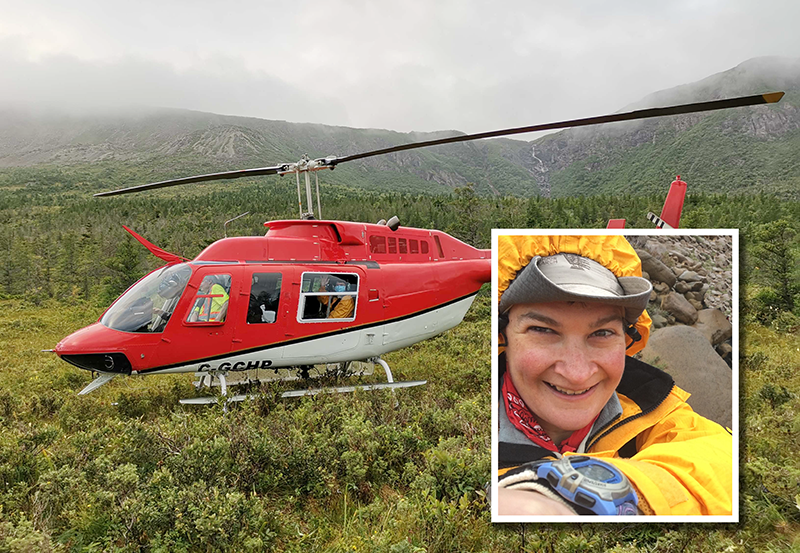Solid-State Physicist Turns to Rocks
Thermoelectric and semiconductor materials have little in common with rocks and pottery. Or so thought Kristin Poduska, a solid-state physicist at Memorial University of Newfoundland and Labrador, Canada, until she took a year-long sabbatical at the Helen and Martin Kimmel Center for Archaeological Science at the Weizmann Institute of Science, Israel. There, Poduska helped elucidate the origins and formation conditions of millennia-old geological and anthropogenic samples from sites including Neolithic villages that had been buried for thousands of years. To uncover the histories of these ancient objects, she used the spectroscopy and surface chemistry techniques that she had previously used in Canada to examine pristine, lab-made semiconductor materials. But now, rather than pristine samples, she was working with specimens that had been buried for thousands of years. She says that she found it deeply satisfying that she could use standard materials-science techniques to answer questions about items that came from the ground. Physics Magazine caught up with Poduska to learn more about the challenges that a solid-state physicist faces when they get their hands dirty.
All interviews are edited for brevity and clarity.
What systems are you currently studying?
Solids that have—at some point in their history—encountered fresh water from streams or salty water from seas. The samples I look at include ones made of the carbonate minerals commonly found in rocks such as limestone or marble and in human-produced chunks of plaster or mortar. All these systems contain minerals that can react with water in a way that changes their microstructure or even their chemical composition.
Once you have a sample, what questions about its past are you trying to answer?
What it is and when and how it stabilized in its current form.
For archaeological samples, answering the “when” involves doing various chemical tests to find fragments suitable for carbon dating. We are looking for pristine fragments, as the interaction of water with some the materials in some archeological finds can interfere with the original carbon content, making carbon dating harder.
We also perform tests to understand how different minerals erode, so that we can understand why some archaeological and geological samples seem to survive better than others. My team and I recently carried out tests for carbonate minerals that we treated to make them more robust to water erosion.
What was the biggest challenge you encountered when you first started studying rocks and archaeological materials?
Learning how to do fieldwork. With my team, I've been to remote corners of Newfoundland to collect samples of calcite rocks. It’s critical to note exactly where the rock was found because that context is essential for piecing together its history and composition. You also need to get good at distinguishing minerals by sight, as it’s not always feasible to go back and collect more samples after a trip.
That said, some of the instruments I use are now small enough to take on field expeditions. I can connect the instruments to a laptop in my hotel room and take initial measurements of my finds while I still have the chance to collect new samples; this strategy was one of the most important ones I learned on my sabbatical. Those checks also give me something to do on rainy days.
Can a rock’s minerals provide information about the environmental conditions of the rock’s home?
Oh yes. One of my projects involves characterizing white calcium carbonates that form in western Newfoundland near high-pH groundwater springs that can host microbes. We’ve found that these carbonates undergo a specific water–mineral reaction known as serpentinization. If someone were to spot the signatures of this mineral in a satellite or drone image, they could use them to identify other areas where the same reaction might have occurred. That information could help prioritize where to focus further investigations—be they on Earth or another planet; my work in Newfoundland is part of an effort to simulate a mission to Mars that would look for sites that could have hosted microbes. How the structures of carbonate rocks and objects have been changed by the environment also provides inspiration for strategies for mitigating climate change.
How so?
For successful long-term carbon sequestration in rocks, we need to understand the processes by which carbon dioxide gets incorporated into minerals. The tools that we can use to do that are the same ones we use to examine archeological and geological samples that have encountered water.
Another application is restoring the oceans’ acidities to pre-industrial-revolution levels. Using knowledge of how natural weathering changes the crystal structures of carbonates in exposed rock surfaces, we can develop ways to monitor and understand whether technologies that mimic such processes could rebalance the pH of Earth’s oceans.
What do your previous semiconductor physics colleagues think about your switch to geophysics and archeology?
They have all really embraced it. The students, particularly, are really clued into the fact that the climate is changing and it’s up to everyone to do something about it. They love seeing how solid-state physics can help with that. It’s rejuvenating.
–Rachel Berkowitz
Rachel Berkowitz is a Corresponding Editor for Physics Magazine based in Vancouver, Canada.





